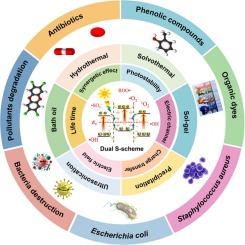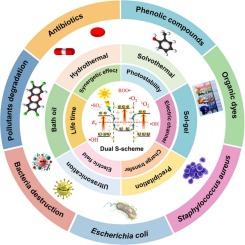Coordination engineering in dual S-scheme heterojunction for photocatalytic applications: Research progress, key challenges and future horizons
IF 23.5
1区 化学
Q1 CHEMISTRY, INORGANIC & NUCLEAR
引用次数: 0
Abstract
The photocatalysis processes have been proven to be promising strategies for environmental remediation. Thus, it is of excellent research value to develop high-performance photocatalytic feedstocks with visible light response and stability. In this regard, heterojunction photocatalysts including type-I, -II, -III, Z-scheme, and S-scheme have shown great promise in various photocatalytic implementations. However, decreasing electron-hole recombination, ensuring light absorption, and enhancing redox abilities through the aforementioned photocatalysts have been regarded as some of the prime factors in the photocatalysis processes that remain challenging. Herein, as robust interfacial contact via three coordinated constituents, dual S-scheme heterojunctions for various photocatalytic implementations are reviewed. Initially, different heterojunction materials such as type-I, -II, -III, and Z-/S-scheme heterojunctions are discussed from recent reports. Then, in order to provide researchers and industrialists a better understanding of this novel class of heterojunction implementations in photocatalysis, a whole section has been devoted to examples of preparation and applications of dual S-scheme heterojunctions for photocatalytic wastewater remediation and bacteria photoinactivation. Benefits and drawbacks in elaborating dual S-scheme heterojunction photocatalysts for the same purposes are addressed as well. This review attempts to encourage a rational design of dual S-scheme heterojunctions through three constituents coordination by choosing the adequate components to push the photocatalysis processes to their scalability barriers and unpractical applications.


双s型异质结光催化配位工程:研究进展、关键挑战和未来展望
光催化过程已被证明是一种很有前途的环境修复策略。因此,开发具有可见光响应和稳定性的高性能光催化原料具有重要的研究价值。在这方面,异质结光催化剂包括i型,-II型,-III型,z型和s型在各种光催化实现中显示出很大的希望。然而,通过上述光催化剂减少电子-空穴复合、确保光吸收和增强氧化还原能力一直被认为是光催化过程中仍然具有挑战性的一些主要因素。本文综述了双s型异质结在不同光催化实现中的应用。首先,从最近的报道中讨论了不同的异质结材料,如i型,- ii型,- iii型和Z-/ s型异质结。然后,为了让研究人员和实业家更好地理解这种新型异质结在光催化中的应用,一整节都致力于双s方案异质结在光催化废水修复和细菌光灭活中的制备和应用实例。此外,还讨论了用于相同目的的双s型异质结光催化剂的优点和缺点。本文试图通过选择合适的组分来推动光催化过程的可扩展性障碍和非实际应用,从而鼓励通过三组分协调来合理设计双s型异质结。
本文章由计算机程序翻译,如有差异,请以英文原文为准。
求助全文
约1分钟内获得全文
求助全文
来源期刊

Coordination Chemistry Reviews
化学-无机化学与核化学
CiteScore
34.30
自引率
5.30%
发文量
457
审稿时长
54 days
期刊介绍:
Coordination Chemistry Reviews offers rapid publication of review articles on current and significant topics in coordination chemistry, encompassing organometallic, supramolecular, theoretical, and bioinorganic chemistry. It also covers catalysis, materials chemistry, and metal-organic frameworks from a coordination chemistry perspective. Reviews summarize recent developments or discuss specific techniques, welcoming contributions from both established and emerging researchers.
The journal releases special issues on timely subjects, including those featuring contributions from specific regions or conferences. Occasional full-length book articles are also featured. Additionally, special volumes cover annual reviews of main group chemistry, transition metal group chemistry, and organometallic chemistry. These comprehensive reviews are vital resources for those engaged in coordination chemistry, further establishing Coordination Chemistry Reviews as a hub for insightful surveys in inorganic and physical inorganic chemistry.
 求助内容:
求助内容: 应助结果提醒方式:
应助结果提醒方式:


